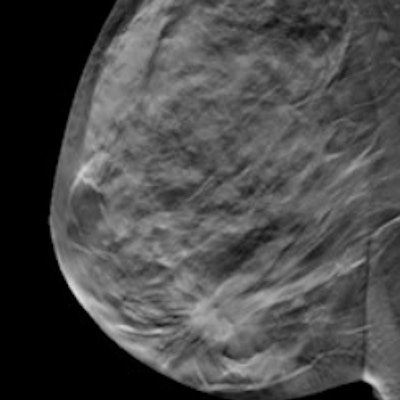
Breast cancers are more conspicuous on digital breast tomosynthesis (DBT) compared with full-field digital mammography (FFDM), especially on the craniocaudal (CC) view, according to a study published online May 14 in Radiology.
But even though breast lesions are more visible on the CC view, the findings support the use of two-view DBT for breast cancer screening, wrote a team led by Dr. Katrina Korhonen of the University of Pennsylvania in Philadelphia.
"Our results support the use of two-view digital breast tomosynthesis screening because we showed that some cancers are better seen ... at one of the two screening views," the team wrote.
Previous research has shown that DBT has benefits over digital mammography for breast cancer screening, but differences in cancer visibility between the two modalities have been unclear, Korhonen and colleagues noted. So the authors explored differences in cancer conspicuity between modalities and mammographic views.
Their study included combined digital mammography and DBT studies for 197 screen-detected cancers found between October 2011 and December 2014.
The team discovered the following:
- Cancers were more likely to be highly visible on DBT than on digital mammography, with an odds ratio of 2.4 (p < 0.01).
- On both digital mammography and DBT, cancers were more likely to be visible on the CC view than on the mediolateral oblique (MLO) view (DBT versus digital mammography odds ratio for CC, 1.6; digital mammography odds ratio for MLO, 1.7; p < 0.01 for both).
- Cancers seen on one view only were more often found in the CC view than the MLO view for both DBT and digital mammography (DBT versus digital mammography odds ratio for CC, 1.6; DBT versus digital mammography odds ratio for MLO, 3.6; p < 0.01).
"Our data confirmed that cancers were more likely to have high conspicuity at DBT than at digital mammography," the group wrote. "When analyzed by view, the cancers were significantly more conspicuous at the CC DBT view than at the CC digital mammography view, and at the MLO DBT view than at the MLO digital mammography view, supporting that lesion conspicuity was improved at DBT versus digital mammography, regardless of the view."
The improved visibility of breast cancer lesions on DBT compared with digital mammography could be from DBT's multiple angle acquisition of the breast image, but it's not yet clear why cancers are more obvious at the CC view, the authors noted. More research is needed.
"Radiologists should be aware that findings suspicious for cancer seen at only one view may be clinically significant and therefore should be completely evaluated," the team wrote. "Future studies including a larger number of breast cancer cases and more readers are needed to corroborate our results."




















